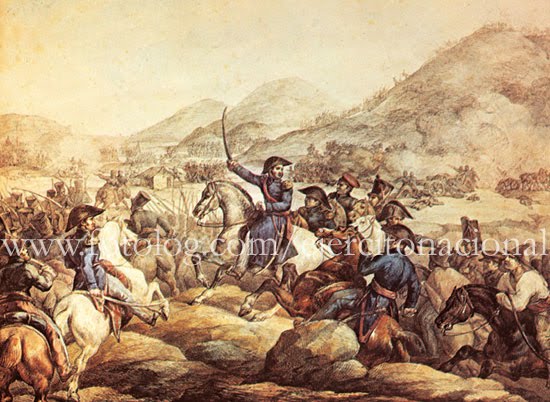¡Guerra a muerte!.- Peru’s last stand against Colombia.
The year of 1816 started with a Colombian offensive towards Peru. Colombia’s liberators, Nariño, Bolivar, Santander and Sucre started to cross the Andes in their March to Lima, through the Andes. A hard fight awaited before them, as the Andes were a natural defensive terrain. Nonetheless, by this point, Colombia had a clear advantage over Lima in manpower, troop experience and morale, and finally equipment. Even when the outbreak of the war between the United States and Great Britain in late 1815 made obtaining a constant flow of supplies almost impossible, Colombia still had enough stockpiles to finish the war. However, it made Miranda think that Colombia should have its own industries, so it wouldn’t have to rely on powers like Britain or the US.
The first battle of the March to Lima ended in disaster as Bolivar’s army was defeated disastrously near Cajamarca. Everybody knew it would give Peru a couple of months at best, but nonetheless none of the other Colombian leaders felt good about using their soldiers as cannon folder. A law was passed in the Colombian parliament, which would come to be known as the War to Death decree that called for the complete defeat of Peru. Miranda took advantage of this to foster early nationalist feelings in the people of Colombia, calling them to fight for their country and for those who they love.
The next offensive was trusted in Sucre, a general best suited for defense than for attack, but the government hoped he would be able to take over the Peruvian position. Meanwhile, Chile continued a separate offensive, and the newly independent Charkas started to gather troops to do one as well. The objective was not defeating Peru as much as relieving pressure so the Colombian attack could succeed. La Plata didn’t send any troops as they were locked in the middle of a Civil War and Paraguay, under Doctor Francia, decided to remain strictly isolationist, but sent some support.
Sucre managed to break through the Peruvian lines in early 1816, and he continued his advance towards Lima, supported by Nariño’s forces. Santander conducted another offensive in the Andes at the same time, but it was meant only to distract Lima and allow the main army to continue their march in the coast.
Colombia also had the support of the Republiquetas and various indigena guerillas, who wished to create a state for themselves. Miranda promised to do so in the Treaty of Cuzco, which was actually signed in Santiago but was named like that only to remember the ancient capital of the Inca Empire. However, with the time, it would come to be known as the Criollo Backstab.
Peru withdrew its forces from the South to do its last stand against the libertador Army, but at the end the Colombian’s won and captured Lima. The Viceroy was captured and forced to sign Peru’s formal surrender and, in light of Spain’s current conflict, accept the independence of Latin America as the king’s representative. The document would have no real validity, but Miranda thought that some form of recognition was needed to appease the elites and the people of Colombia.
Chilean forces attacking South Peru.
With Lima captured started the age known in Peru as the “nueva colonia”, with Miranda stablishing a protectorate over the Peruvian areas and forcing its elites to recognize the independence of Charkas and the Colombian control over certain territories, namely Tumbes and several territories in the Amazonas. Sucre, nicknamed “Virrey” by the Peruvian people, assumed control over the protectorate, which would have Colombian and Chilean armies stationed over strategic points all over the country. To say the people of Peru was unhappy would be an understatement. Open revolt broke all over the new country, but they were mostly militias unable to go against the experienced Colombian troops. The total number of casualties is a debate matter, as, understandably, Colombia tends to downplay them while Peru raises them. Even the name of the events are very divisive, as Peru names them as “the Protectorate Massacres” while Colombia uses “the Royalist Guerilla Wars”.
Flag of the Peruvian Protectorate.
The mestizos of Peru were trapped between these events, and most of them even fled to Colombia, specifically Quito. Once the situation in Peru was stabilized enough, Colombia called for all of Latin America to join in a Conference to decide the future of the continent, the Cucuta Congress.



.svg/125px-Flag_of_Peru_(1821_-_1822).svg.png)
